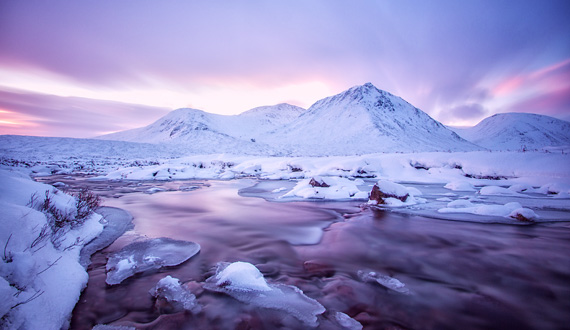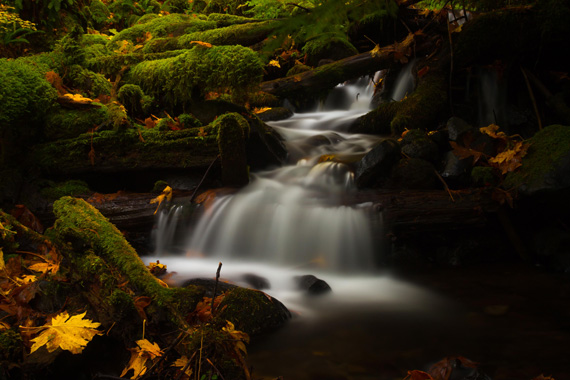Neutral density or ND filters have the sole purpose of cutting down the amount of light as a whole. A perfect neutral density filter would transmit all wavelengths of light equally, so there would be no color change. Though not actually perfect, it can be used equally well in both color photography or black and white photography.

Photo by john mcsporran.
It is made in a wide variety of densities. Depending on the manufacturer, there are currently two rating systems commonly used to designate the density of neutral density filters.
- A straightforward system of whole numbers whereby an ND-1 indicates a need for a 1-stop exposure increase; ND-2 is two stops; ND-3 is three stops; and so on.
- In the other, which is scientifically oriented, the decimal number .3 indicates a 1-stop exposure increase need; .6 is for two stops; .9 is for three stops; and so on.
Typical Uses of ND Filters:
1. To Blur Action – Sometimes it is desirable to use a relatively slow shutter speed to indicate movement or to show an object’s path. If a fast film is in use in bright light, or if a wide aperture is needed to limit depth of field, the correct exposure might ordinarily require an undesirably high shutter speed. An appropriate neutral density filter makes any desired shutter speed possible.
2. To Reduce the Effect of Transitory Events – Long exposures can “remove” all moving objects from a picture. That is, if you are photographing a building or site under circumstances where passing automobiles, pedestrians, or site workmen might be unwanted picture elements, the use of a long exposure will delete such transitory presences; they will not be in one place long enough to record on the film. (In long time exposures an allowance must be made for reciprocity failure.
3. To Reduce Depth of Field – By keeping the shutter speed unaltered when neutral density filters are introduced, the lens aperture can be opened to reduce the depth of field in the image. The use of shallow depth of field, remember, tends to visually isolate the subject, because everything not in the principal plane of focus will appear not sharp.

Photo by Luke Detwiler.
4. To Prevent Overexposure of Fast Film – In very bright light, you may find it impossible to avoid overexposing a very fast film, especially with the very large and relatively slow shutters found on view camera lenses. (These frequently limit fast speeds to no more than 1/125 or 1/250 of a second.) Occasionally, you might find yourself with only one type of film remaining unused at the end of a day and then be faced with a situation that requires slower films. By reducing the amount of light entering the camera, neutral density filters allow greater exposure flexibility.
5. Exposure Effects – Several applications of neutral density filters make use of their light-absorption qualities.
About the Author:
Clance Lee (basiccameraphotography.com) is a freelance photographer, mostly taking wedding photographs and portraits. Other than photography, he likes to travel around and occasionally does travel reviews.
Like This Article?
Don't Miss The Next One!
Join over 100,000 photographers of all experience levels who receive our free photography tips and articles to stay current:






I liked the article but reciprocity failure is not an issue for digital cameras, it is a film only issue that essentially states the effective ISO of the film drops as the length of exposure is increased. In the film days when one shot a long exposure (about 1 second or more) you had to add more time than the meter indicated to correct for the lower effective ASA/ISO. With a digital camera one does not have to give any extra exposure, i.e. a five stop ND filter means you need to increase your exposure by 5 stops (32 times longer shutter speed) as explained by Patrick in the previous comment. The word reciprocity failure comes from the fact that the reciprocal nature of f-stop and shutter speed failed at long exposure times.
We digital shooters can’t get all happy though as with a digital camera the sensor warms up during the exposure and the amount of noise increases.
I enjoyed your article, but I noticed a slight error in your “straightforward” naming of ND filters. Unfortunately, it is anything but, unless you have a mind for numbers and like to know the whys of things. An ND-2 filter blocks one stop of light, a ND-4 removes two stops, etc. Whole number naming comes from the number being the exponent of two (2), to which each filter holds back light.
For example, (ND-Y) where Y=2^X reduces light by X stops ==>
2^1=2 (ND-2) one stop,
2^2=4 (ND-4) two stops,
2^3=8 (ND-8) three stops and so forth.
An ND-32 filter, which would be 32=2^5, therefore five stops. Admittedly it is simplified after ND-64 (six stops). ND-400 is eight stops and ND-1000 is ten stops. A stop is defined as a doubling or, in the case of ND filters, halving of the amount of light reaching the film or sensor plan. Reducing two stops is halving the light twice or 1/2 *1/2=1/4 of the light.
Further, the first two commenters are misleading themselves. As to point #1 above: Even at say, ISO 100, which is the slowest on many digital cameras, in bright light (ie. “Sunny 16”) exposure would be 1/100 at f/16. If one wants to limit depth of field, shifting exposure to larger aperatures would increase shutter speed. Which, as we all know. would facilitate stopping action, not blurring action as desired. In this case, ND filters could actually be of more use to the digital user than to the film user, who still has the option of film down to ISO 25. I actually agree with the comment about point #4, it mentions view cameras. Digital backs do exist for view cameras, such as 4×5 and larger, but are prohibitively expensive so not practical in day to day shooting.
As far as HDR being a substitute for ND filter, I greatly disagree. HDR, or High Dynamic Range, in order to have more gradations of black to white than what the camera’s sensor can normally record, has nothing to do with decreasing shutter speed or limiting depth of field. ND filters are specific to what they do. HDR is not what they do.
Also, as some people may agree, getting the image right in camera is way more elegant for some photographers, including me, then hours in post production, even if automated. I prefer to use the computer six inches behind the viewfinder of my camera. Good day.
I’ve seen these articles. I even have some neutral density filters; somewhere. What is a mystery to me is why, if you are using digital cameras, would you use these filters. An overall ND filter would be useful in some circumstances but with the advent of digital and HDR it seems to me that the usefulness for a graduated or split ND filter has been passed. It’s just difficult for me to see why these would be useful when HDR is a better, and far more elegant, solution to the problem of excessive scene brightness range.
Nathan, I am of similar mindset on using HDR or exposure blending in most instances, but still carry a set of ND filters specifically for water and waterfall shots. Being able to get the cotton candy look while the sun is out is invaluable.
Given the prevalence of digital cameras, I believe that it would have been helpful if you had framed some of the comments in terms of both digital photography and film photography, not just film photography. All of your comments also apply to digital photography; however, I would not be surprised if some digital camera users dismiss items 1and 4 because they reference film photography, only.